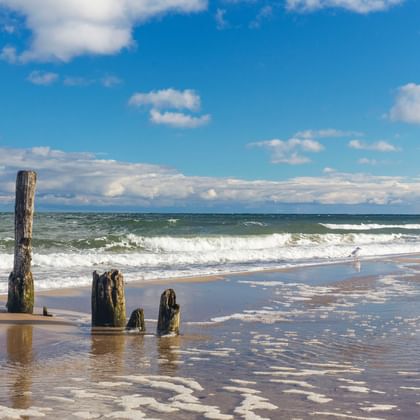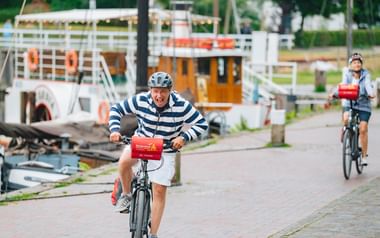Lübeck
Lübeck is a city in northern Germany, which was the capital of the Hanseatic League in the Middle Ages.
Coming from the train station, you will find the first historical building – the Holsten Gate.
It is located at the western end of the old town and houses a museum, which is a great first sight, because here you get to know Lübeck and learn more about the place before starting a walk in the old town.
Lübeck's old town is located on an island in the middle of the river Trave. It can be reached via five bridges and has been designated a UNESCO World Heritage Site.
Our Nordic beauty Lübeck has retained the charm of the original port city and openly welcomes you with its motto "Concordia domi foris pax" - harmony within, peace without.

Numerous sights stretch throughout the old town. But if you want to experience a small journey through time, you should leave the wide road and explore the small streets on the edge.
At the Obertrave you will find a promenade over 700m long, which invites you to take a seat in one of the numerous restaurants and bars. The listed buildings, which are also located on the promenade, give the place a timeless and idyllic atmosphere.

To get to know the North German region from a different perspective, small boat trips on the Trave and Wakenitz are ideal. The surroundings of the old town and the untouched nature of the Wakenitz let you see the city from a different perspective.
One of the most famous landmarks of Lübeck is the Marienkirche. It is not only one of the oldest churches, but also the third largest in Germany. It dates back to the 14th century and is considered a prime example of German brick Gothic.
The famous marzipan at Café Niederegger is not the only speciality of the city.
As the Baltic Sea is only 16 kilometres away, fish is considered one of the most local delicacies. The people of Lübeck love their cod in mustard sauce and we are sure that you will.

Boltenhagen
Germany's third largest and currently most modern butterfly park is located near the Osteseebad.
In the summer months you can see up to 600 adult butterflies here, belonging to up to 100 different species. The approximately 700-square-metre flying hall is a wonderful destination for all those who admire colourful butterflies.
Bothmer Castle rises imposingly not far from the Baltic Sea in Klützer Winkel. It is one of the largest baroque palace complexes, brilliantly staged by its beautiful landscape park.
Covering an area of 11.7 hectares, the castle is difficult to find because it lies in a hollow and cannot be seen at first.
Another excursion destination we can recommend is the monastery, which was founded in 1171. Through generous donations, the monastery quickly acquired extensive landholdings and was used as the burial place of the Mecklenburg dynasty of princes, thus gaining great political and economic importance. Prince Pribislaw's death led to the monastery being destroyed during riots in 1178.
Wismar
Even from a distance, you can recognise a pointed-arched passageway with high light penetration, three storeys above. It is the last of the once five medieval town gates in Wismar. It was built on the harbour area in 1450.
The port of Wismars was, thanks to its gun position, an important trading centre in the period before the Industrial Age. This made Wismar one of the most important cities in Europe during the Hanseatic period.
Today there are many ports where ships of all types and sizes dock. The harbours are lined with pretty old houses, where many great restaurants and bars have settled. What could be nicer than to watch the historical sailors in the sunshine and enjoy the maritime flair?
If the weather doesn’t work, you can always find a place in “old Sweden. ” It is one of the oldest townhouses in the city, which was converted into a restaurant in 1878. The open fireplace and two ship models in the interior provide a cozy atmosphere that invites.
Bad Doberan
The Teepott is hardly to be overlooked with its impressive roof construction. This place is perfect for watching the ships on the promenade, the Baltic Sea. You can pick up a drink in one of the restaurants and cafés in the Teepott Inner.
To toast your holiday, there is a cocktail bar in the building.
Outside the village along picturesque avenues, meadows and fields, parallel to the Baltic Sea beach, there is the possibility to ride with Molli, the Mecklenburgische Bäderbahn. Molli is a steam-powered narrow-gauge railway that takes you through Bad Doberan in a 40-minute drive.
The Kornhaus is located in the middle of the oldest monastery complex in Mecklenburg-Western Pomerania. With a variety of events, it is a socio-cultural meeting place for people of all ages. In the inner house there is an exhibition on the history of the Konhaus and a small cozy café in the monastery garden next door.

Barth
After 1990, the port of Barth has developed into a major centre for maritime tourism in the region.
Barther Hafen has state-of-the-art berths, which attracts sailors and water sports enthusiasts from all over Germany.
Due to its excellent environmental management, the port was awarded the “Blue Flag. ”
The Barther Sailing/Port Days take place here every year in July. Water sports enthusiasts from all over Europe come to the area to experience the charming interplay of the Bodden waters and the Baltic Sea.
Stralsund
Two years after its opening in 2008, the Ozeaneum was named European Museum of the Year. As a result, it has become a magnet for millions of visitors to the Hanseatic city.
The 87,000 square metres feature five permanent exhibitions, including the "1:1 Giants of the Seas". It is Europe's largest whale exhibition and delights visitors with lifelike models. A fascinating animal world is presented in the huge aquariums of the building.
In the largest aquarium, which holds over 2.8 million litres of water, you can marvel at schools of fish, sharks and rays. Things are a little more relaxed on the roof terrace, where the Humbolt penguins have their home.
The Marine Museum in the Old Town shows lionfish, seahorses and coral fish in its tropical aquariums. Dad Highlight for turtle lovers is the huge 350,000 litre tank where wonderful sea turtles can be seen through a 25 square metre window. Also particularly impressive are the skeleton of a 15-metre-long fin whale and a taxidermied polar bear. This shows that marine science and biodiversity are just as much a theme in the museum as whales, coral reefs and fishing.
"The Gateway to the Island of Rügen" - also known as the Rügen Bridge has become a new landmark of the Hanseatic city with its almost 130 high pylons. It leads from Stralsund about 4.1 kilometres to the largest island in Germany, Rügen. As a vantage point, this bridge gives you a super overview of the sea and the city.

Usedom
Usedom is a great place to explore by bike. 200 kilometres of cycle paths invite you to take extensive discovery tours. They lead along the Baltic Sea coast, past impressive architecture, through forests and into the quiet seclusion of the hinterland. The long sandy beach is also ideal for long walks and letting the wind blow around your nose. They say the Baltic Sea is a capricious mistress. Sometimes with white ridges, sometimes smooth as glass, sometimes bubbling and foaming. But if the sky over the Baltic Sea is grey in the morning, it doesn't mean that the day will be a washout. Because the sun loves the island of Usedom and gives it more than 2,000 hours of sunshine a year.
Many highlights alternate: wander through Ahlbeck - Heringsdorf - Basin and discover the summer residences in classicism, mansions in renaissance style and domiciles in art nouveau. Even today, the whitewashed facades, the small turrets and gables with their filigree ornaments still shine. Strolling along the kilometre-long promenade from pier to pier, you can still feel the glamour of the imperial spas' past.
Es wechseln sich viele Highlights ab: Streifen Sie durch Ahlbeck - Heringsdorf - Basin und entdecken Sie die Sommerresidenzen im Klassizismus, Herrenhäuser im Stil der Renaissance und Domizile im Jugendstil. Noch heute strahlen die weiß getünchten Fassaden, die kleinen Türmchen und Giebeln mit den filigranen Ornamenten um die Wette. Flaniert man über die kilometerlange Promenade von Seebrücke zu Seebrücke, spürt man auch heute noch den Glanz der Vergangenheit der Kaiserbäder.




